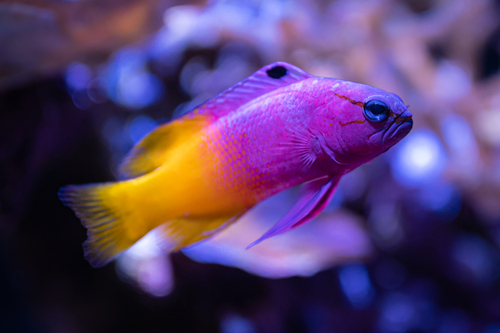You’ll need to figure out what makes the royal gramma tick to find additional fish for your aquarium. Find out the most compatible fish from our list of the 15 best royal gramma tank mates!
The best Royal Gramma Tank Mates are fish that have not only a matching temperament with the gramma, but can also withstand the same levels of cold or heat. A lack of the same dietary needs, like food timing or type of food, is also necessary.
In this article we’ll go over the 15 best Royal gramma tank mates. We’ll supply a brief description of each potential neighbor, as well as some pros and cons to keeping them with your royal gramma. With so much information to cover, let’s get started!
Contents
Royal Gramma Tank Mates – What You Need to Know
The lovely royal gramma has it’s set of care standards that you must meet, but in doing so, you should also know what makes tank mates most ideal for the royal gramma. Let’s examine these factors in the summaries below.
Temperament
A royal gramma has a very zen vibe. To put it another way, their temperament is peaceful and calm. Instead of engaging in fights or posturing with bolder fish, the royal gramma is more likely to hide in rocks or coral for safety.
This means, in order to minimize stress, you’ll need tank mates that are also peace-loving, or at least likely to stay in their own territory and not go looking for the royal gramma to start trouble.
Size
The size of a royal gramma is only 3 inches. This petit but beautiful little fish can be mistaken for a snack if you don’t find other fish that are similar in size. Try not to go above six-inch fish, unless they don’t eat fast-moving meat.
Competition
When it comes to food, the royal gramma is happy eating little crustaceans, zooplankton, or any tiny critters. What you should be careful of is having too many tank mates that enjoy the same foods, because they might just edge your royal gramma out of getting enough to eat.
Parameters & Tank Setup
The royal gramma is happiest in 30 gallons of water. It loves to hide and duck in and out of coral, plants, and rocks. It also needs a temperature that hovers between 72 and 78 degrees Fahrenheit to stay healthy. Find tank mates that thrive in the same conditions!
Best Royal Gramma Tank Mates
Since you’ve got a good idea of basic care requirements for your royal gramma, let’s go on to see the best tank mates!
- Blue Chromis
- Atlantic Blue Tang
- Hawkfish
- Clownfish
- Striped Squirrelfish
- Yellowhead Jawfish
- Firefish goby
- Orangemarked Goby
- Engineer Goby
- Sleeper Blue Dot Goby
- Boxfish
- Foxface Rabbitfish
- Barred Spinefoot
- Zebra Angelfish
- Regal Angelfish
Now we’ll show you why each tank mate listed is a good fit.
You will also like these other popular posts in this category:
1. Blue Chromis
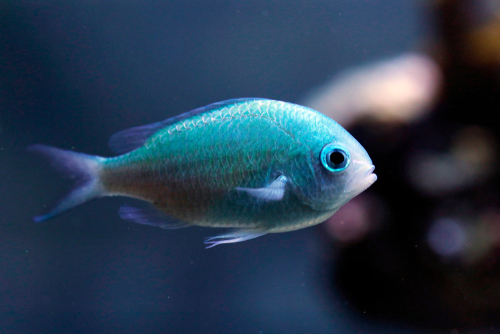
- Scientific Name: Chromis viridis
- Adult Size: 3 inches
- Compatible With: Royal Gramma
- Care Level: Easy
- Origin: Pacific Ocean
The blue chromis, also called the green chromis or blue green chromis, is a truly gorgeous addition to any aquarium. It is small, but bright, with a pale bottom but most of its coloration concentrates to the edges of its body.
The blue chromis is peaceful, which is just what your royal gramma needs.
Pros of keeping with Royal Gramma:
- No aggression
- No food competition
Cons of keeping with Royal Gramma :
- None
2. Atlantic Blue Tang

- Scientific Name: Acanthurus coeruleus
- Adult Size: 9 inches
- Compatible With: Royal Gramma
- Care Level: Medium Difficulty
- Origin: Atlantic Ocean
Most people know of the term “blue tang” from a certain beloved animated fish with memory problems. The Atlantic blue tang shares some visual similarities with that type of tang, but instead of yellow, this fish is larger and blue all over!
In addition to being pretty, though large, the Atlantic blue tang is fine to leave the royal gramma alone as long as it has enough room to explore.
Pros of keeping with Royal Gramma:
- No aggression
- No food competition
Cons of keeping with Royal Gramma :
- None
3. Hawkfish
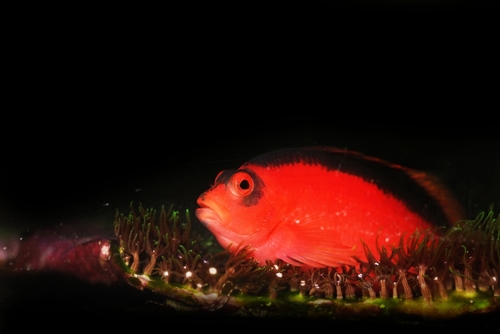
- Scientific Name: Neocirrhitus armatus
- Adult Size: 3 and a half inches
- Compatible With: Royal Gramma
- Care Level: Easy
- Origin: Australia, Fiji, Pacific Ocean, Cook Islands
The hawkfish can be found in several places around the world, but the main thing to remember about this fish is that it can be a little fierce. It likes to live at the bottom of the tank, and it needs 40 gallons to feel safe.
Though this fiery red fish, with its striking black stripes, can be a little aggressive, this is avoidable for your royal gramma. Just make sure there are plenty of rocks and reefs to hide in!
Pros of keeping with Royal Gramma:
- No food competition
Cons of keeping with Royal Gramma :
- Some chance of aggression without enough room and obstacles.
4. Clownfish
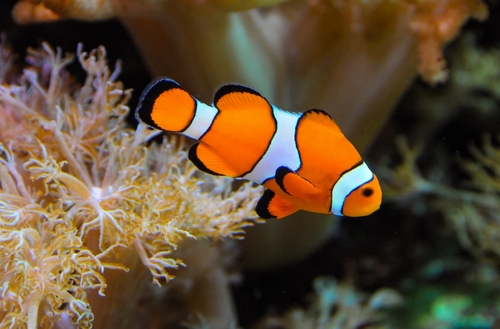
- Scientific Name: Amphiprion ocellaris
- Adult Size: 3 inches
- Compatible With: Royal Gramma
- Care Level: Easy
- Origin: North Australia, Indo-Pacific Oceans
The clownfish, another highly popular type of aquarium dweller, is a favorite because while it is peaceful, it is fun to watch dip in and out of hiding places.
The clownfish will not harm your timid royal gramma. It prefers to hang out at the top or top-middle of the aquarium’s space, anyways!
Pros of keeping with Royal Gramma:
- No aggression
- No food competition
Cons of keeping with Royal Gramma :
- None
5. Striped Squirrelfish
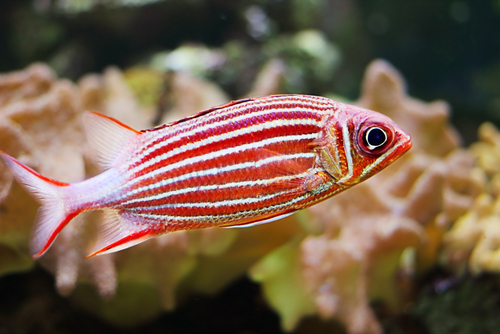
- Scientific Name: Sargocentron xantherythrum
- Adult Size: 7 inch
- Compatible With: Royal Gramma
- Care Level: medium Difficulty
- Origin: Pacific Ocean
Squirrelfish are gorgeous and wild to look at. They are Usually red with white pinstripes, like a dapper-dressed gentleman! However, sometimes they can also be silver with red fins.
Regardless of white type you get, there are two things you should remember about striped squirrelfish. The first is that they are peaceful. The second is that they have sharp spines which can get tangled in fine or trailing obstacles, and hurt anything that brushes against them.
Pros of keeping with Royal Gramma:
- No aggression
- No food competition
Cons of keeping with Royal Gramma :
- Can get stuck on trailing obstacles and cause injury with fins.
6. Yellowhead Jawfish
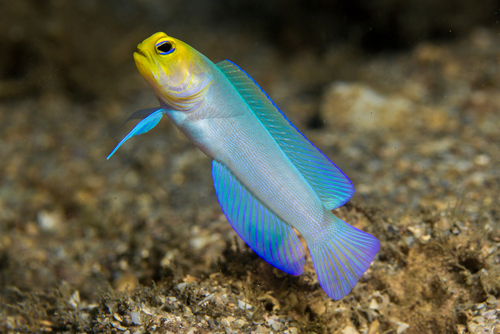
- Scientific Name: Opistognathus aurifrons
- Adult Size: 4 inches
- Compatible With: Royal Gramma
- Care Level: Easy
- Origin: Western Central Atlantic
The yellowhead jawfish sport a yellow skull and a blue-green, pale body. They are beautiful, and interesting to watch burrow at the bottom of the aquarium.
These fish are happiest in rubble and sand. They are typically shy, making them great temper-matchups with royal grammas.
Pros of keeping with Royal Gramma:
- No aggression
- No food competition
Cons of keeping with Royal Gramma :
- None
7. Firefish goby

- Scientific Name: Nemateleotris magnifica
- Adult Size: 3 inches
- Compatible With: Royal Gramma
- Care Level: Easy
- Origin: Coral Sea, Maldives, Africa
Prepare to be stunned by the interesting but alien look of the firefish goby, also called fire gobies or, more accurately, magnificent dartfish!
These fish have a sort of grumpy-looking slant to their eyes, despite their peaceful nature. They are long, thin, and begin with deep red at the tails, fading into white, and finally yellow at the head. But the defining characteristic is a long, antenna-like dorsal fin that makes them very fun to look at.
Pros of keeping with Royal Gramma:
- No aggression
- No food competition
Cons of keeping with Royal Gramma :
- None
8. Orangemarked Goby
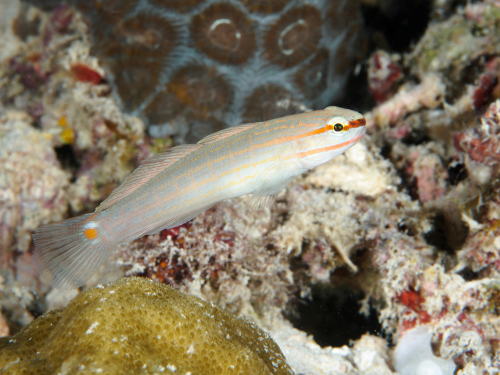
- Scientific Name: Amblygobius decussatus
- Adult Size: 3 inches
- Compatible With: Royal Gramma
- Care Level: Easy
- Origin: Australia, Indian Ocean, Indonesia, Pacific Ocean
Orangemarked gobies are another fascinating fish to look at. They are long, slender, and pale, with eye-grabbing fire-colored or dark speckles.
These fish are peaceful. They are sand sifting, meaning they love to burrow and dig in soft substrate. They’ll keep their distance from the shy royal gramma.
Pros of keeping with Royal Gramma:
- No aggression
- No food competition
Cons of keeping with Royal Gramma :
- None
9. Engineer Goby
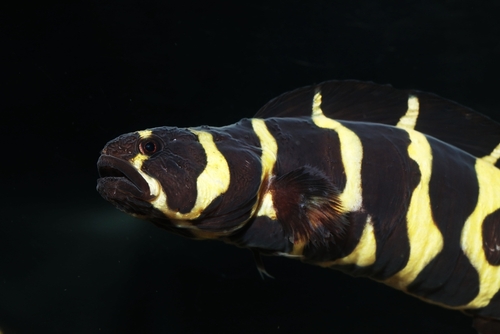
- Scientific Name: Pholodichthys Leucotaenia
- Adult Size: 13 inches
- Compatible With: Royal Gramma
- Care Level: Moderately Difficult
- Origin: Pacific Ocean
These gobies look a lot like eels with long bodies. They are yellow and black with mottled markings, almost like stripes, which earn them the other name “Convict goby.”
This fish is long, and will need a large tank with plenty of space. Despite it’s big size, it is typically peaceful and will not go out of it’s way to hunt down and eat your royal gramma, which is an expert hider.
Pros of keeping with Royal Gramma:
- No aggression
- No food competition
Cons of keeping with Royal Gramma :
- None
10. Sleeper Blue Dot Goby
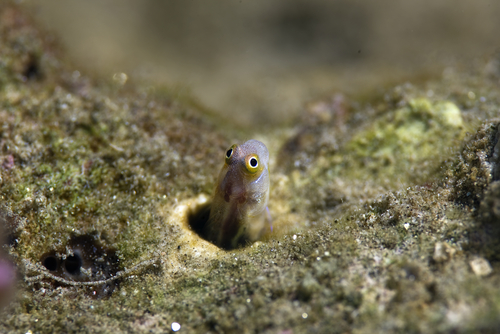
- Scientific Name: Valenciennea sexguttata
- Adult Size: 2 inches
- Compatible With: Royal Gramma
- Care Level: Easy
- Origin: Pacific Ocean, Indian Ocean
This fish is known as the Ladder Goby or even Sixspot sleeper. This fish is white, with funny bulbous eyes and bright blue spots underneath each.
This fish likes to burrow, like most gobies, and is pretty gentle and peaceful.
Pros of keeping with Royal Gramma:
- No aggression
- No food competition
Cons of keeping with Royal Gramma :
- None
11. Boxfish
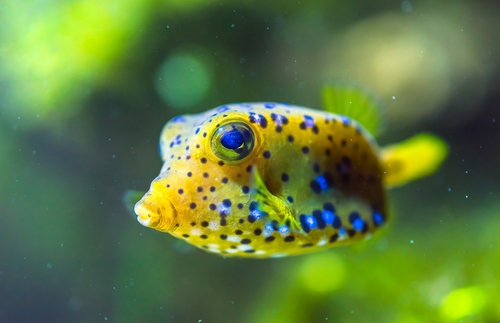
- Scientific Name: Ostracion cubicus
- Adult Size: 18 inches
- Compatible With: Royal Gramma
- Care Level: Difficult
- Origin: Southeastern Atlantic Ocean
This fish is beautiful to look at and compatible with most other fish. The problem is, this fish can be hard to care for because of it’s semi-aggressive temper, big size, and dangerous poisonous ability.
Before you write this fish off as a bad tank mate, however, you should know that it only secretes poisonous mucus if startled, and there is little chance of a shy royal gramma doing that. It will be compatible as long as there is enough room, at least 127 gallons, and plenty of obstacles in the aquarium.
Pros of keeping with Royal Gramma:
- Compatible with shy royal gramma
Cons of keeping with Royal Gramma :
- Can be poisonous
- Can be aggressive
12. Foxface Rabbitfish
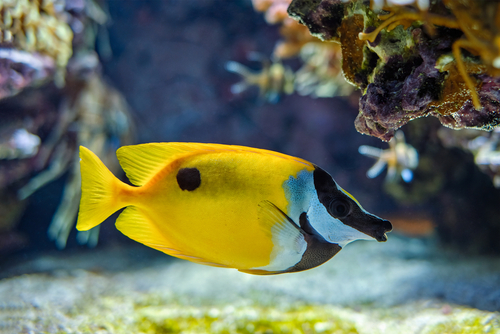
- Scientific Name: Siganus vulpinus
- Adult Size: 9 inches
- Compatible With: Royal Gramma
- Care Level: Easy
- Origin: Great Barrier Reef, Indonesia
This beautiful fish is named for it’s long, snout-like face with black markings, much like a fox. It is otherwise mostly yellow, with some white framing the face and a spiky set of fins.
This fish is mostly peaceful, though large. It needs plenty of reef-like hiding places to be comfortable.
Pros of keeping with Royal Gramma:
- No aggression
- No food competition
Cons of keeping with Royal Gramma :
- None
13. Barred Spinefoot
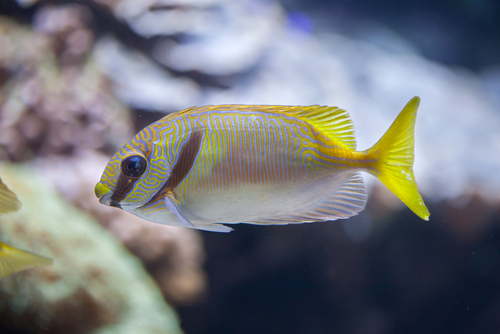
- Scientific Name: Siganus doliatus
- Adult Size: 10 inches
- Compatible With: Royal Gramma
- Care Level: Easy
- Origin: Pacific Ocean
The Barred Spinefoot is a fish named for it’s bar-like marking, which is usually orange or tan, over smaller, more minute but beautiful blue markings. This is all overlaid on top of pale to bright yellow coloring.
This fish is quite adorable to look at, though it is large. It is peaceful, but it can be poisonous if any fish attacks and is pricked by it’s spines. Luckily, the shy royal gramma is unlikely to run this risk!
Pros of keeping with Royal Gramma:
- No aggression
- No food competition
Cons of keeping with Royal Gramma :
- Does have poisonous spikes.
14. Zebra Angelfish
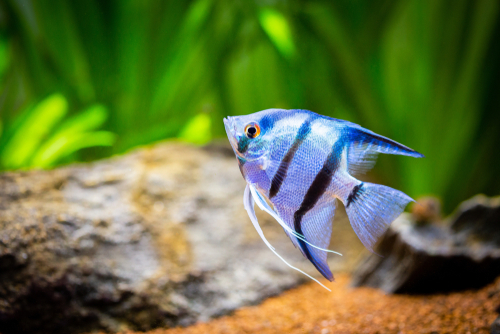
- Scientific Name: Pterophyllum scalare
- Adult Size: 10 inches
- Compatible With: Royal Gramma
- Care Level: Easy
- Origin: South America
The zebra angelfish is another of the large tank mate options for the royal gramma. It is striking, with a white body sometimes marked by yellow, but always striped with black. Its eyes are red and its fins are sharply pointed.
This fish is a semi-aggressive one, but with enough room and obstacles, it won’t chase down the hiding royal gramma or over-stress it.
Pros of keeping with Royal Gramma:
- No food competition
Cons of keeping with Royal Gramma :
- Some risk of aggression
15. Regal Angelfish
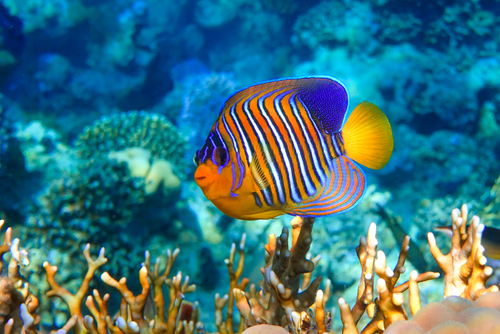
- Scientific Name: Pygoplites diacanthus
- Adult Size: 10 inches
- Compatible With: Royal Gramma
- Care Level: Difficult
- Origin: Red Sea, Indian Ocean
The regal angelfish is also called the empress angelfish, and has earned its name. It is yellow, white, and blue striped.
This fish shows up so vibrantly in the aquarium that it is a joy to look at. However, it is big, making it slightly harder to accommodate. Still, in terms of temper, this is a gentle giant.
Pros of keeping with Royal Gramma:
- No aggression
- No food competition
Cons of keeping with Royal Gramma :
- None
In Conclusion
To sum it all up, the 15 best royal gramma tank mates are aquarium swimmers who don’t mind similar tank parameters to the gramma. They should also be relatively peaceful and not large enough to think they can snack on the pretty purple fish. Choose from our list above to get the best results!

Ian Sterling, founder of Fishlab.com, began his aquarium journey over 30 years ago, driven by a deep fascination for fish and their diverse personalities. His website, Fishlab.com, is dedicated to making fishkeeping accessible and enjoyable, offering beginner-friendly guidance, expert insights, and a community for aquarists to connect and share experiences.


